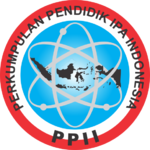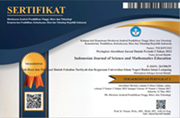Augmented reality as an interactive multimedia in developing student's visual intelligence on molecular geometry material
Abstract
Keywords
References
D. Shavkidinova, F. Suyunova, and J. Kholdarova, “Education is an Important Factor in Human and Country Development,” CURRENT RESEARCH JOURNAL OF PEDAGOGICS, vol. 04, no. 01, pp. 27–34, Jan. 2023, doi: 10.37547/pedagogics-crjp-04-01-04.
Y. Rahmawati, H. Dianhar, and F. Arifin, “Analysing Students’ Spatial Abilities in Chemistry Learning Using 3D Virtual Representation,” Educ Sci (Basel), vol. 11, no. 4, p. 185, Apr. 2021, doi: 10.3390/educsci11040185.
D. Saputra, B. Gürbüz, and H. Haryani, “Android-based Animation for Chemical Elements and Experiments as an Interactive Learning Media,” J.Sci.Learn, vol. 2021, no. 2, pp. 185–191, 2021, doi: 10.17509/jsl.v4i2.28787.
A. Nisa, I. Y. Rifki, A. Alya, and K. Dwiningsih, “The Validity of Molecular Geometry Based Virtual Reality to Improve Student Visual-Spatial Intelligence in New Normal Era,” JOURNAL OF EDUCATIONAL SCIENCES, vol. 5, no. 3, pp. 393–408, 2021, doi: 10.31258/jes.5.3.p.%25p.
A. D. Siregar and L. K. Harahap, “Pengembangan E-Modul Berbasis Project Based Learning Terintegrasi Media Komputasi Hyperchem Pada Materi Bentuk Molekul,” JPPS (Jurnal Penelitian Pendidikan Sains), vol. 10, no. 1, pp. 1925–1931, 2020, doi: 10.26740/jpps.v10n1.p1925-1931.
H. Gardner, Frames of Mind : The Theory of Multiple Intelligences, 3rd ed. New York: Basic Books, 2011.
P. N. Azizah and A. Lutfi, “Development of a WordPress-Based Learning Website to Train Students’ Visual Intelligence on Chemical Equilibrium Material,” Jurnal Paedagogy, vol. 10, no. 3, pp. 692–702, Jul. 2023, doi: 10.33394/jp.v10i3.7994.
F. R. S. Zebua, “Analisis Tantangan dan Peluang Guru di Era Digital,” Jurnal Informatika dan Teknologi Pendidikan, vol. 3, no. 1, pp. 21–28, Jun. 2023, doi: 10.25008/jitp.v3i1.55.
N. J. Harahap, C. H. Limbong, and F. S. Simanjorang, “The Education in Era Society 5.0,” Jurnal Eduscience, vol. 10, no. 1, pp. 237–250, 2023.
F. E. Nastiti, A. R. Ni’mal ’abdu, and J. Kajian, “Kesiapan Pendidikan Indonesia Menghadapi era society 5.0,” Jurnal Kajian Teknologi Pendidikan, vol. 5, no. 1, pp. 61–66, Apr. 2020.
R. G. P. Panjaitan, A. B. Tenriawaru, S. Pitiporntapin, N. I. Rifanka, F. Fitriyani, and N. Hayati, “Development of Augmented Reality-Based Learning Media,” Jurnal Pendidikan Sains Indonesia, vol. 12, no. 4, pp. 820–832, Oct. 2024, doi: 10.24815/jpsi.v12i4.39410.
A. Fombona-Pascual, J. Fombona, and R. Vicente, “Augmented Reality, a Review of a Way to Represent and Manipulate 3D Chemical Structures,” J Chem Inf Model, vol. 62, no. 8, pp. 1863–1872, 2022, doi: 10.1021/acs.jcim.1c01255.
R. Hakiki, M. Muchson, O. Sulistina, and A. Febriana, “The Development of Learning Media Based on Augmented Reality, Hologram, and Ludo Game on The Topic of Molecular Shapes,” International Journal of Interactive Mobile Technologies, vol. 16, no. 4, pp. 70–84, 2022, doi: 10.3991/ijim.v16i04.28989.
B. H. Majeed and H. T. S. ALRikabi, “Effect of Augmented Reality Technology on Spatial Intelligence among High School Students,” International Journal of Emerging Technologies in Learning, vol. 17, no. 24, pp. 131–143, 2022, doi: 10.3991/ijet.v17i24.35977.
D. Ramadhanti, R. Nuryani Suwarno, H. Kuswanto FMIPA, and U. Negeri Yogyakarta, “Literature Review: Technology Development and Utilization of Augmented Reality (AR) in Science Learning,” Indonesian Journal of Applied Science and Technology, vol. 2, no. 4, pp. 135–144, 2021.
S. Dargan, S. Bansal, M. Kumar, A. Mittal, and K. Kumar, “Augmented Reality: A Comprehensive Review,” Mar. 01, 2023, Springer Science and Business Media B.V. doi: 10.1007/s11831-022-09831-7.
H. Herwin, L. D. Prasojo, B. Saptono, and S. C. Dahalan, “Analyzing the Impact of Augmented Reality on Student Motivation: A Time Series Study in Elementary Education,” Ingenierie des Systemes d’Information, vol. 28, no. 5, pp. 1197–1203, 2023, doi: 10.18280/isi.280507.
R. C. Sari, M. Sholihin, N. Yuniarti, I. A. Purnama, and H. D. Hermawan, “Does behavior simulation based on augmented reality improve moral imagination?,” Educ Inf Technol (Dordr), vol. 26, no. 1, pp. 441–463, Jan. 2021, doi: 10.1007/s10639-020-10263-8.
L. N. Izzati and A. Kamaludin, “Indonesian Journal of Science and Mathematics Education Augmented reality-based flashcard media to improve students’ concept understanding in chemistry learning,” Indonesian Journal of Science and Mathematics, vol. 7, no. 2, pp. 252–266, Jul. 2024, doi: 10.24042/ijsme.v5i1.20975.
A. Buchori, F. Ganda Putra, and N. D. Rahmawati, “AR-based interactive GeoGebra learning media for optimizing transformation geometry learning in higher education,” Indonesian Journal of Science and Mathematics Education, vol. 7, no. 3, pp. 437–450, Nov. 2024, doi: 10.24042/ijsme.v5i1.21345.
E. Sapinatul Bahriah, S. Agung, and A. I. Nur, “DEVELOPMENT OF MEDIA INTERACTIVE BASED ON AUGMENTED REALITY ON CHEMICAL BONDING MATERIALS,” Journal of Chemistry Education Research, vol. 6, no. 2, pp. 93–99, 2022.
N. Kozcu Cakir, G. Guven, and C. Celik, “Integration of Mobile Augmented Reality (MAR) Applications into the 5E Learning Model in Biology Teaching,” International Journal of Technology in Education, vol. 4, no. 1, pp. 93–112, Dec. 2020, doi: 10.46328/ijte.82.
C. H. Chuang, J. H. Lo, and Y. K. Wu, “Integrating Chatbot and Augmented Reality Technology into Biology Learning during COVID-19,” Electronics (Basel), vol. 12, no. 1, pp. 1–29, Jan. 2023, doi: 10.3390/electronics12010222.
L. A. Andreani and B. Yonata, “Validity Test of E-LKPD to Improve Students’ Argumentation Skills on Chemical Equilibrium Material,” Hydrogen:Jurnal Kependidikan Kimia, vol. 12, no. 3, pp. 429–439, Jun. 2024, doi: 10.33394/hjkk.v12i3.11500.
Riduwan, Skala Pengukuran Variabel-Variabel Penelitian. Bandung: Alfabeta, 2016.
T. M. Haladyna and M. C. Rodriguez, DEVELOPING AND VALIDATING TEST ITEMS. New York: Routledge, 2013.
R. R. Hake, “Interactive-engagement versus traditional methods: A six-thousand-student survey of mechanics test data for introductory physics courses,” Am J Phys, vol. 66, no. 1, pp. 64–74, Jan. 1998, doi: 10.1119/1.18809.
R. Haryadi and H. Pujiastuti, “Use of augmented reality learning media to improve higher-order thinking skills in kinematics material,” Thabiea : Journal of Natural Science Teaching, vol. 6, no. 1, pp. 37–50, 2023, [Online]. Available: http://journal.iainkudus.ac.id/index.php/Thabiea
Sugiyono, Metode Penelitian Kuantitatif Kualitatif dan R&D. Bandung: Alfabeta, 2019.
M. T. Ghozali, I. D. Amalia Islamy, and B. Hidayaturrohim, “Effectiveness of an educational mobile-app intervention in improving the knowledge of COVID-19 preventive measures,” Inform Med Unlocked, vol. 34, Jan. 2022, doi: 10.1016/j.imu.2022.101112.
M. Abdinejad, B. Talaie, H. S. Qorbani, and S. Dalili, “Student Perceptions Using Augmented Reality and 3D Visualization Technologies in Chemistry Education,” Journal of Science Education and Technology (, vol. 30, no. 1, pp. 87–96, Nov. 2021, doi: 10.1007/s10956-020.
DOI: http://dx.doi.org/10.24042/ijsme.v8i1.26242
Refbacks
- There are currently no refbacks.
Copyright (c) 2025 Unit Riset dan Publikasi Ilmiah Fakultas Tarbiyah dan Keguruan Universitas Islam Negeri Raden Intan Lampung

This work is licensed under a Creative Commons Attribution-ShareAlike 4.0 International License.

Indonesian Journal of Science and Mathematics Education is licensed under a Creative Commons Attribution-ShareAlike 4.0 International License.





